Feb 20, 2018
Ten Books: 2017, Volume 4
This volume covers ten books read in late 2017.
Like lipstick on a pig, color-coded indicators of placements on my Great Novels , Great Sci-fi and Fantasy Novels and Great Crime Novels lists add allure and an air of sophistication and mystery to the reviews of qualifying books.
—
-
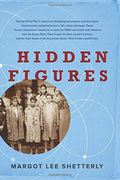 Margot Lee Shetterly - Hidden Figures (2016)
Margot Lee Shetterly - Hidden Figures (2016)
Shetterley traces the history of the African American women who worked as computers and, later, mathematicians and engineers at NACA (the National Advisory Committee for Aeronautics) from the 1940s through and beyond its transition to NASA in 1958. These women made important contributions to the war effort (WWII) and to NASA’s Mercury and Apollo programs. The author focuses much of her book on three women, Katherine Johnson, Dorothy Vaughan, and Mary Jackson, but she includes others missing from the film, most notably Christine Darden.The Oscar-nominated 2016 film Hidden Figures does take significant liberties with the text, much of it in the understandable telescoping of a narrative that encompasses more than twenty years time. It certainly is a powerful and entertaining film.
What a despicable, backward hell-hole of racism was Virginia. (The 2015 film Loving sheds light on its shame as well.) That an integrated Federal institution such as NACA/NASA flourished in the poisonous climate of the state is a wonder.
-
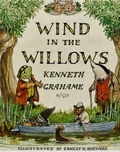 Kenneth Grahame - The Wind in the Willows (1908)
Kenneth Grahame - The Wind in the Willows (1908)
Mr Toad is a character of comic genius, though more sophisticated readers may have trouble crediting the idea that with nothing more than a shawl for disguise, the fast-talking amphibian manages to effect a complex escape from jail in the character of a corpulent washerwoman. Young children will have no difficulties with the idea, of course, and if they are well-versed in the world of the male upper middle class of Edwardian English society, so much the better. -
 Bart D. Ehrman - Did Jesus Exist? The Historical Argument for Jesus of Nazareth (2012)
Bart D. Ehrman - Did Jesus Exist? The Historical Argument for Jesus of Nazareth (2012)
I had a little trouble with the soul of wit on this one, so I relegated my thoughts on it and Vermes (below) to a post of their own. See the aptly-titled Ehrman and Vermes for the full story. -
 19 Daphne du Maurier - Rebecca (1938)
19 Daphne du Maurier - Rebecca (1938)
Another novel well-remembered for its cinematic recreation by Alfred Hitchcock. But unlike The Thirty-Nine Steps (noted here recently) and others, Hitchcock followed this book closely. And why not? It is a very good story and it translates well to the screen. Both the novel (note its placement on a list of great mysteries of the 20th century) and the film (the only Hitchcock film to win the Oscar for Best Picture) have aged well. -
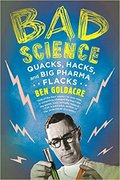 Ben Goldacre - Bad Science (2008)
Ben Goldacre - Bad Science (2008)
An important and entertaining book that should be read by anyone who has had or will have the need to consume food, vitamins, or medication. What exactly are placebos and why should we be taking them (in moderation, of course) regularly? When pharmaceutical companies and much of modern medicine must be viewed hyper-critically and with healthy skepticism always, why are “holistic” and “homeopathic” options so much worse? Why is information about medical and nutritional research reported in popular media so often such a confused, contradictory mess?The answers to these and many other questions are answered in clear, easy-to-follow, logically unassailable, and always entertaining prose. The book should be required reading for all adults. No, that would be too late. Middle school would not be too early and just might be early enough to provide a measure of immunity to a lifetime of brain-numbing misinformation to come.
Dr Goldacre has been threatened and sued by more than a few charlatans and quacks. A particularly harmful one of this number sued to keep his name out of this book. He lost. The author then made the chapter on this cretin freely available as a PDF: The Doctor Will Sue You Now. Please read it.
-
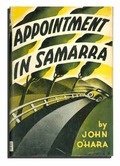 50 John O’Hara - Appointment in Samarra (1934)
50 John O’Hara - Appointment in Samarra (1934)
At some point as I read this novel, I had the thought that its world might occupy a middle ground between the fictional worlds created by O’Hara’s contemporaries Sinclair Lewis and F Scott Fitzgerald. By the end of the book I realized that its fictional Gibbsville, a small city in rural Pennsylvania, was a grittier, less-repressed analogue to Lewis’s Zenith. Or possibly Updike’s Brewer, the small rural Pennsylvania city setting of the Rabbit novels. In any case it’s a fascinating place in its own right, and this is a compelling and satisfying read.O’Hara’s epigram identifies the source of the novel’s title. It is W Somerset Maugham’s retelling of an Arabic folk tale and is worth reading:
The speaker is Death:
There was a merchant in Baghdad who sent his servant to market to buy provisions and in a little while the servant came back, white and trembling, and said, Master, just now when I was in the marketplace I was jostled by a woman in the crowd and when I turned I saw it was Death that jostled me. She looked at me and made a threatening gesture, now, lend me your horse, and I will ride away from this city and avoid my fate. I will go to Samarra and there Death will not find me. The merchant lent him his horse, and the servant mounted it, and he dug his spurs in its flanks and as fast as the horse could gallop he went. Then the merchant went down to the marketplace and he saw me standing in the crowd and he came to me and said, Why did you make a threating gesture to my servant when you saw him this morning? That was not a threatening gesture, I said, it was only a start of surprise. I was astonished to see him in Baghdad, for I had an appointment with him tonight in Samarra.
-
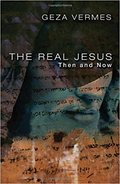 Geza Vermes - The Real Jesus: Then and Now (2003)
Geza Vermes - The Real Jesus: Then and Now (2003)
See Ehrman (above) for all you need to know about the curious absence of my bloviation here on the subject of this book. Find it in exile under Ehrman and Vermes. -
 31 Isaac Asimov - The End of Eternity (1955)
31 Isaac Asimov - The End of Eternity (1955)
I have read more about Isaac Asimov than I have read of his prodigious output. What I had read prior to this is bits of his non-fiction. As a relative newcomer to science fiction, I was aware of his stature in the genre, but daunted by the scope of his output. Where to begin? The Foundations series (originally a trilogy; ultimately a septet): too big a first bite. I, Robot: the entrance to a five-novel-and-scads-of-short-stories rabbit hole. So I chose to dip my toe into the other Asimov entry on my list of 46 Great SciFi/Fantasy Novels of the 20th Century, The End of Eternity. It is fantastic. Arrrgh! Now I want to read them all anyway. A rabbit hole indeed—or should I say, a wormhole—awaits. -
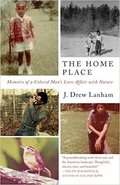 J. Drew Lanham - The Home Place: Memoirs of a Colored Man’s Love Affair with Nature (2016)
J. Drew Lanham - The Home Place: Memoirs of a Colored Man’s Love Affair with Nature (2016)
This is a lovely memoir from a man who has described himself as “a rare and perhaps endangered species: the African-American birder” and has shared his Rules for the Black Birdwatcher. It is the story of how his father’s sense of pride in and stewardship of “a ragged, two-hundred-acre Forest Service inholding” in the piedmont forest of western South Carolina—his family called it “Home Place"—planted the seed of the author’s lifelong love of and interest in nature and the land where it thrives. His memoir traces the process of maturation and education that allowed him to create an academic career of his passion (currently, he is a Professor of Ecology at Clemson University).The final chapter in the book is a sad coda. Lanham writes of the feeling of connectedness to the land of his immediate ancestors which led him to an attempt to trace his roots farther into the past. But he was unable to do so: the barbarity of slavery has wiped all of that history away. It remains a hopeful book despite this melancholy finish.
-
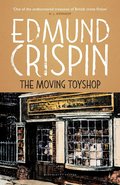 3 Edmund Crispin - The Moving Toyshop (1946)
3 Edmund Crispin - The Moving Toyshop (1946)
I’ve enthused on the subject of Douglas Adams’s quirky detective Dirk Gently here recently. Reading the opening paragraphs of this novel, a hilarious account of Crispin’s Oxford Don and amateur sleuth Gervase Fen’s out-of-control automotive entrance to the grounds of St Christopher’s College, I couldn’t help but imagine it to be a spot-on homage to Gently’s chaotic motoring style. Except, of course, that it was written 40 years before the advent of the Holistic Detective Agency. So I have instead stumbled upon, surely, one of Adams’s inspirations. The similarities between Fen and Gently do not end with their struggles with motor cars. Oxford is another obvious link.Toyshop settles down a bit into a somewhat more conventional British detective novel. There are no metaphysical doings, despite the mysterious appearance and subsequent disappearance of the titular toyshop. Conventional-ish, anyway. It is certainly more comic than most. Dickensian is a fair description of its humor and, not quite as laudably, its fantastical coincidences. A rollicking read though, and I’ll look forward to more from Crispin’s resourceful and endearing Professor Fen.
| DATE | TITLE |
| 12/09/2019 | Books 2019: #2 Dozen Really Matter? |
| 05/20/2019 | Why Not Both? |
| 04/23/2019 | Books 2019: #1 Take Ten |
| 04/15/2019 | Books 2018: #31 - #37 |
| see also ... | 113 Great 20th Century Novels |
| 46 Great 20th Century Crime Novels | |
| 45+ Great 20th Century SciFi/Fantasy Novels | |
| Books Read (2008-) | |
| Index of Book Posts |
-
Categorically
- Home
- Index
- ALS Bites
- Birding
- Blather
- Bloviation
- Crosswords
- Unbelievable
- Vidiocy and Other Stolen Stuff
Goodies

